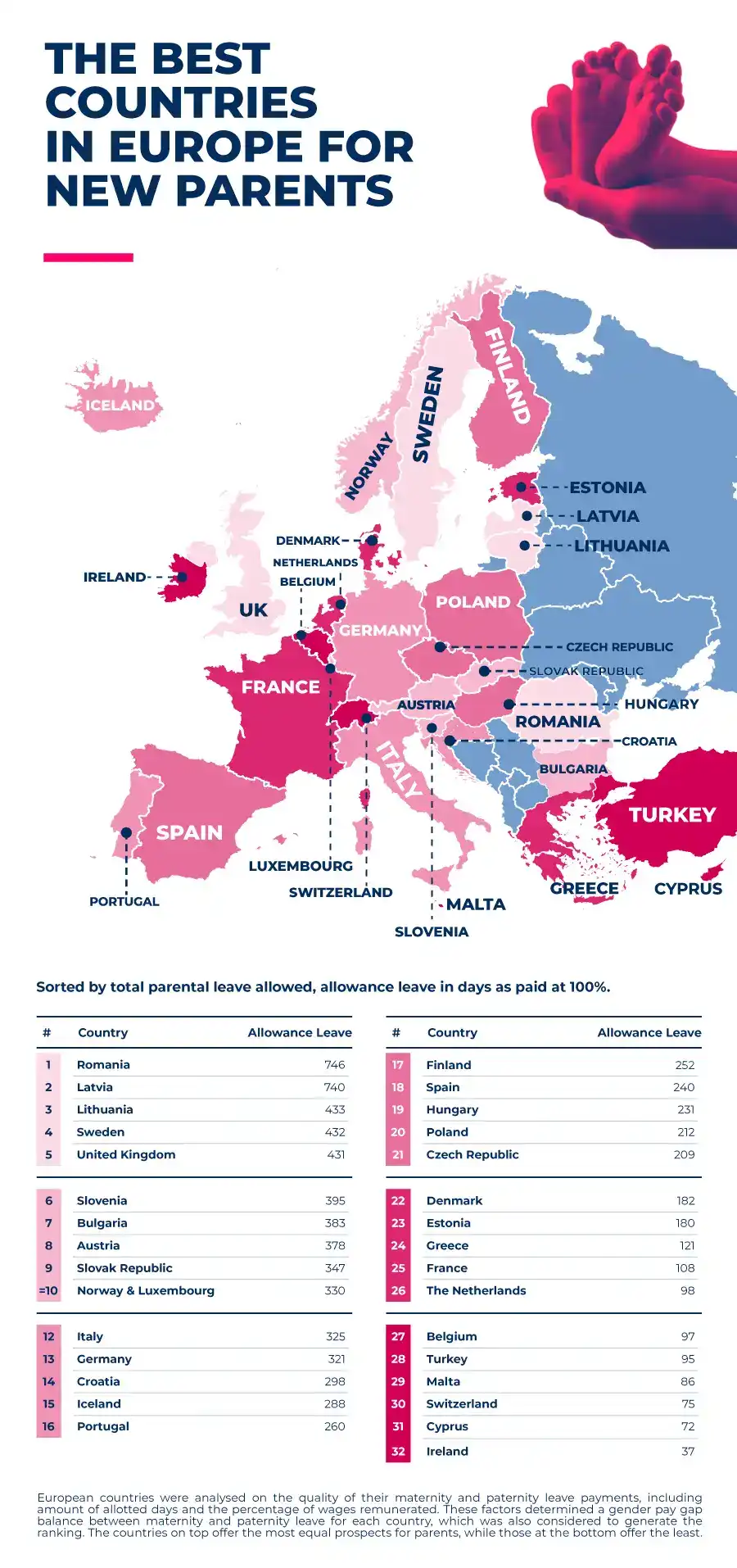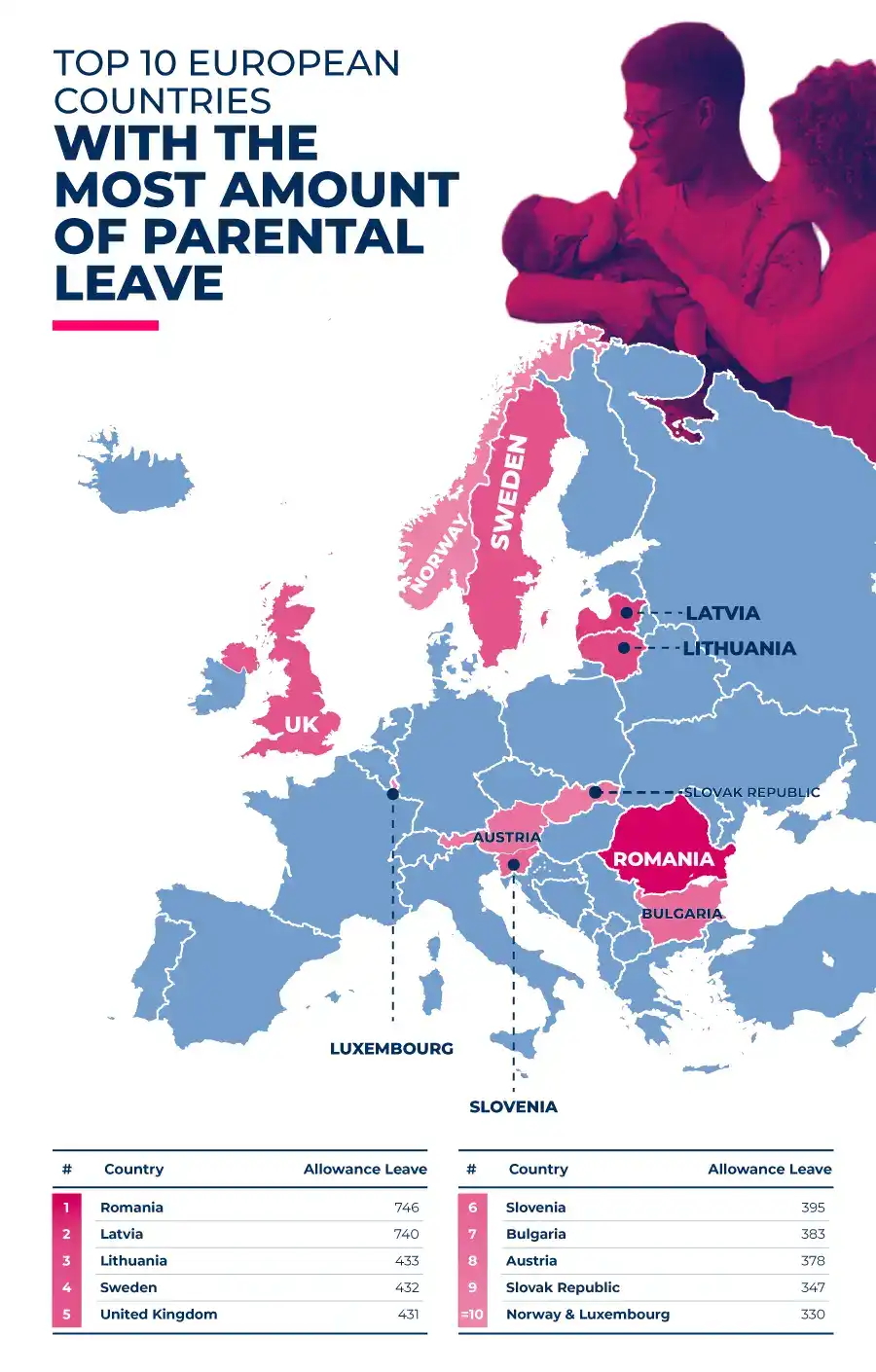
The Best European Countries to Become a Parent
Anyone who has ever thought about having a baby has inevitably asked the questions “But how much time off do I get?” and “How much will I be paid?”. It can vary wildly between jobs, but there are minimum amounts set by law. Reboot Digital PR Agency decided to take a look at the countries of Europe and find out just which, exactly, are the best to become a parent in.
We looked at a few different criteria to decide. Ultimately the countries are ranked by how many paid days off new parents receive, but we also gathered data on paid leave exclusively for new mothers and new fathers and the difference between the two.

Top 10 European Countries With The Most Amount Of Parental Leave

1. Romania
Romania offers new parents the highest number of paid leave days at a whopping 746 days. 111 of these are designated for new mothers while new fathers get 15. This leaves 621 days for the new parents to split as they see fit.
Romania also ranks highly, in eighth place, for the percentage of leave days mothers receive which is 56%. Following shortly behind it places 11th place for percentage for fathers. The differences in the percentage show how much one parent may be favoured over the other and were used to calculate our gender gap score.
2. Latvia
Latvia gives new parents the second highest amount of paid leave on our list at a huge 740 days. 448 of these go to mothers but just 8 go to fathers. They then have 284 days to share. This gives Latvia a gender gap score of 77.40.
While mothers get a delightful 590 days of leave, this is 80% of the total leave awarded to parents so ranks Latvia low in 25th place for gender gap.
3. Lithuania
New parents in Lithuania get a generous 433 days leave, with 98 going to new mothers and 23 going to new fathers. This leaves 311 to share between them as they see fit. Due to the difference between the amounts of days leave, Lithuania has a gender gap score of 25.80.
New mothers in Lithuania receive 59% of leave allowed and so Lithuania ranks 9th for gender gap and maternity leave. They come eighth for fathers leave and third for total parental leave.
4. Sweden
Sweden is pipped to the post by Lithuania, with one day fewer leave overall (432). It achieves a gender gap score of 0.00.
Sweden offers 432 days of leave divided equally between mothers and fathers, at 216 each. Sweden also takes first place when it comes to total leave dedicated to fathers. While they are generous, Sweden only ranks fourth at total parental leave allowed.
5. United Kingdom
New parents in the UK receive 431 total days of paid leave. 234 of these go to mothers while fathers receive just 9. This leaves them with 188 days to split between them. The UK achieves a gender gap score of 74.20.
The UK ranks low on our list for most things, despite the good amount of leave offered. It comes in at 24th place for both gender gap and mother’s leave due to the sizable difference between maternity and paternity leave. It also places only 19th for paternity leave. It does unsurprisingly score highly for total parental leave in fifth place, as it offers a sweet 431 days total parental leave.
6. Slovenia
New mothers in Slovenia are offered 105 days of paid leave, while fathers receive just 30. A remaining 260 to share between them means they get 395 total. Slovenia has a gender gap score of 29.00.
Slovenia ranks 10th in terms of gender gap and mothers leave, and ranks sixth for fathers leave and for total parental leave.
7. Bulgaria
New parents in Bulgaria get 383 days total paid leave, with 41 days going to the mother and 14 days going to the father. This leaves 329 days for them to share between themselves. This gives Bulgaria a gender gap score of 12.90.
Bulgaria ranks fifth for gender gap and leave for mothers, an unlucky 13th for fathers leave and comes seventh in terms of total parental leave.
8. Austria
New parents in Austria get a total of 378 days of paid leave. 80 of these go to the mother whereas just 6 go to the father. This leaves 292 to share between them and gives Austria a gender gap score of 32.30.
Austria ranks 11th for gender gap and mothers leave, while for fathers leave it ranks 23rd. In terms of total parental leave it comes in eighth place.
9. Slovak Republic
The Slovak Republic offers new parents 347 days of total leave. New mothers get 128 of these while new fathers get, technically, none. Both parents share the remaining 219. This gives the Slovak Republic a gender gap score of 48.40.
The Slovak Republic ranks 16th for gender gap and mother’s leave. It joins Croatia and comes 29th for fathers leave and ranks in 9th place for total parental leave.
10. Norway and Luxembourg
Norway offers new parents 330 total days of paid leave, with 75 days going to mothers and just 10 to fathers. This leaves 245 days for them to split and gives Norway a gender gap score of 35.50.
Norway ranks 12th for gender gap and mothers leave. It ranks 15th for leave dedicated to fathers. In terms of total parental leave it comes in 10th place.
Luxembourg, meanwhile, also offers new parents 330 days of paid leave. However, 140 of these go to the mother. The fathers in Luxembourg also receive just 10 days, which leaves 180 for the new parents to share. This gives Luxembourg a gender gap score of 54.80.
Luxembourg comes in 18th place for gender gap and mothers leave. For fathers leave it also comes 15th place and it ranks joint 10th with Norway for total parental leave.
Top 10 European Countries With The Least Amount Of Parental Leave

1. Ireland
Ireland offers new parents just 37 days of paid leave, 27 for mothers and 10 for fathers. This gives Ireland a gender gap score of 64.50.
Ireland fares slightly better than the Czech Republic, ranking 21st for gender gap and mother’s leave and 15th for fathers leave. But it comes last in the ranking for total parental leave at an underwhelming 32nd place.
2. Cyprus
New parents in Cyprus are offered 72 days of paid leave. Mothers receive 65 of these, while fathers get the remaining 7. This gives Cyprus a gender gap score of 93.50.
Cyprus comes in 30th place for gender gap and leave for mothers. It comes in 21st place for father’s leave and a second lowest score of 31st place for total parental leave.
3. Switzerland
Swiss parents can expect 75 days paid leave, with 64 of these going to mothers and 11 going to fathers. This gives Switzerland a gender gap score of 83.90.
Switzerland ranks at just 27th place for gender gap and maternity leave. Paternity leave fairs distinctly better at 14th but overall, Switzerland lands at the lowly 30th place for total parental leave.
4. Malta
Malta offers new parents 86 days of paid leave. 81 of these go to mothers while fathers receive the remaining 5. This gives Malta a gender gap score of 96.80.
Malta is only in 31st place for gender gap and mother’s leave, the second lowest in our list. For father’s leave they do a little better in 24th place. For total parental leave, they come in at 29th place.
5. Turkey
Turkey offers new parents 95 days of paid leave. 80 of these go to mothers while fathers receive just 5. This leaves 10 days for new parents to share. This gives Turkey a gender gap score of 90.30.
Turkey is at a low 29th place for gender gap and leave dedicated to mothers. For father’s leave it is slightly better in 24th place. For total parental leave it is at just 28th place.
6. Belgium
New parents in Belgium are offered 97 days of leave, with 59 of these going to mothers and 14 to fathers. This leaves a remaining 14 days for them to split between them. Belgium achieves a gender gap score of 67.70.
Belgium ranks 22nd for gender gap and mother’s leave and comes in at 12th for fathers leave. Belgium is one of the lowest scorers for total parental leave, at just 27th place.
7. Netherlands
The Netherlands offers new parents just 98 days of paid leave, with 80 of these going to mothers and 18 going to fathers. This gives the Netherlands a gender gap score of 80.60.
The Netherlands comes in 26th place for gender gap and mother’s leave. For father’s leave they land at a vastly better 10th place, but come 26th overall for total parental leave.
8. France
France offers new parents 108 days of paid leave. Mothers get 80 of these while fathers get 28. This gives France a gender gap score of 71.00.
France lands in 23rd place for gender gap and mothers leave but is one of the higher scores for fathers leave in 7th place. But for total parental leave France is at a low again, in 25th place.
9. Greece
New parents in Greece can expect 121 days of paid leave, with 119 of these going to mothers. Fathers get the remaining 2. This gives Greece a gender gap score of 100.00.
Greece places in last place for gender gap and mother’s leave, at 32nd. For father’s leave, they do not do much better at 28th. For total parental leave they come at a slightly more respectable 24th.
10. Estonia
New parents in Estonia receive 180 days of paid leave, with mothers getting 140 of these. Fathers don’t technically get any paid leave, but there is a remaining 40 days for the parents to split. This gives Estonia a gender gap score of 87.10.
Estonia places a low 28th for their gender gap score and leave dedicated to mothers and a slightly worse 29th for leave dedicated to fathers. Overall, Estonia comes in at 23rd place for total parental leave.
Methodology:
1. To identify the best European countries to become parents and raise a family, internet research was conducted using python’s library Selenium in order to iterate through web pages such as Eurostat and OECD and scrape from them specific information for each European country. From this, we collected the average duration and wage of paid maternity and paternity leave per country.
2. The data was pre-processed to obtain the days of paid paternity and maternity leave, since countries remunerate employees at a different rate during this period, the output was used to calculate the actual number of paid days if employees were receiving 100% of the wage.
3. To identify the best countries to become parents in Europe, the gap between maternity and paternity paid days was calculated as percentage change and used to create a chart.
4. Finally, data was visualised into a heatmap ranked on the gender gap between maternity and paternity paid days, showing detailed information such as the number of paid days for maternity and paternity and the respective rate.